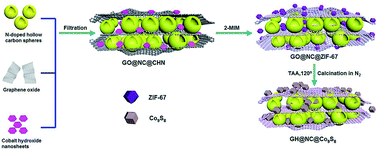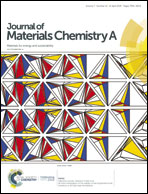MOFs-derived Co9S8-embedded graphene/hollow carbon spheres film with macroporous frameworks for hybrid supercapacitors with superior volumetric energy density†
Abstract
Electrode materials with macroporous structures have desirable structural advantages, which can provide excellent reaction sites for electrons and ions. In this study, a novel macroporous nanostructure is synthesized utilizing N-doped hollow carbon spheres and ZIF-67 derived Co9S8 embedded in graphene (GH@NC@Co9S8). This macroporous nanostructure can maximize the entire surface area, which provides a favorable transport environment for the electrons and ions of the electrolyte. Furthermore, in situ grown Co9S8 polyhedra derived from ZIF-67 can improve the reactivity and specific capacity of the composite due to their amorphous phase and hollow three-dimensional structure. The as-prepared GH@NC@Co9S8 acts as a binder-free electrode for supercapacitors; it shows a high volumetric capacitance of 842.4 F cm−3 at a current density of 1 A g−1. An asymmetric supercapacitor fabricated with GH@NC@Co9S8 (positive electrode) and GH@NC (negative electrode) shows a superb volumetric energy density of 28.7 W h L−1 at a high power density of 971.9 W L−1 and long cycle life (95.8% capacity retention after 8000 cycles). This device has great practical value in electrochemical energy storage.

- This article is part of the themed collection: 2019 Journal of Materials Chemistry A Most Popular Articles


 Please wait while we load your content...
Please wait while we load your content...